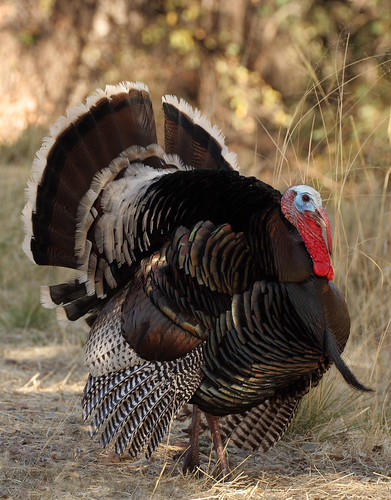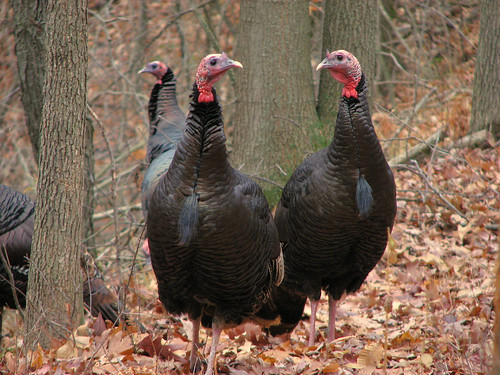 It's almost Thanksgiving, and everybody's thinking of turkey. But long before Thanksgiving existed, turkeys were here in North America.
It's almost Thanksgiving, and everybody's thinking of turkey. But long before Thanksgiving existed, turkeys were here in North America.Turkeys are among the largest birds in our area, with a wingspan over 4 feet and weighing up to 24 pounds. The stereotypical Thanksgiving pose -- tailfeathers fanned out, feathers fluffed up -- is a display that males put on to attract mates, but also when they feel threatened. Not so surprising, then, that this is our picture of turkeys at Thanksgiving time.
As another display tactic, male turkeys have featherless heads that can be bright blue during mating season, complemented by bright red throat, wattles (the floppy part under the beak), snoods (a flap that dangles over the beak), and caruncles (other red growths around the neck and head. Males also have a curious tuft of hairs coming out of the middle of their chests called a beard. If he puts on a successful show, each male typically maintains a harem of several females. Meanwhile, the females can get away with being smaller and less colorful -- in fact, they need to be, as they're the ones that tend the nests.

By the early 1900's, turkey populations in North America had been decimated by hunting. But wildlife managment programs have made a concerted effort to bring the bird back through habitat protection and re-introduction of birds where they had disappeared. For example, the Maryland Department of Natural Resources estimates that the wild turkey population in Maryland has rebounded from about 2,000 turkeys in two or three counties in 1973, to over 30,000 birds in 2008, with wild turkeys in every Maryland county.
In the wild: Turkeys are found throughout Maryland and Virginia in a variety of habitats. In the summer, they seek out areas with berries, grasses, and insects, including both woods and meadows. In the fall and winter, they may increase the time they spend in the woods as they seek out acorns. Many of the times that we have seen wild turkeys have been along rivers; they tend to nest within a few hundred yards of water.
 In your yard: Wild turkeys have been known to stray into more urban and suburban areas occasionally, but in general, they're very wary of people. (We have to wonder, though, whether domesticated turkeys will get in on the urban poultry phenomenon at some point.)
In your yard: Wild turkeys have been known to stray into more urban and suburban areas occasionally, but in general, they're very wary of people. (We have to wonder, though, whether domesticated turkeys will get in on the urban poultry phenomenon at some point.)More info:
An excellent report from the Maryland DNR: The Wild Turkey in Maryland
Sounds of Wild Turkeys from the National Wild Turkey Foundation
Like the photos in this post? Mouse over for credits; a click takes you to the photographer on Flickr.


